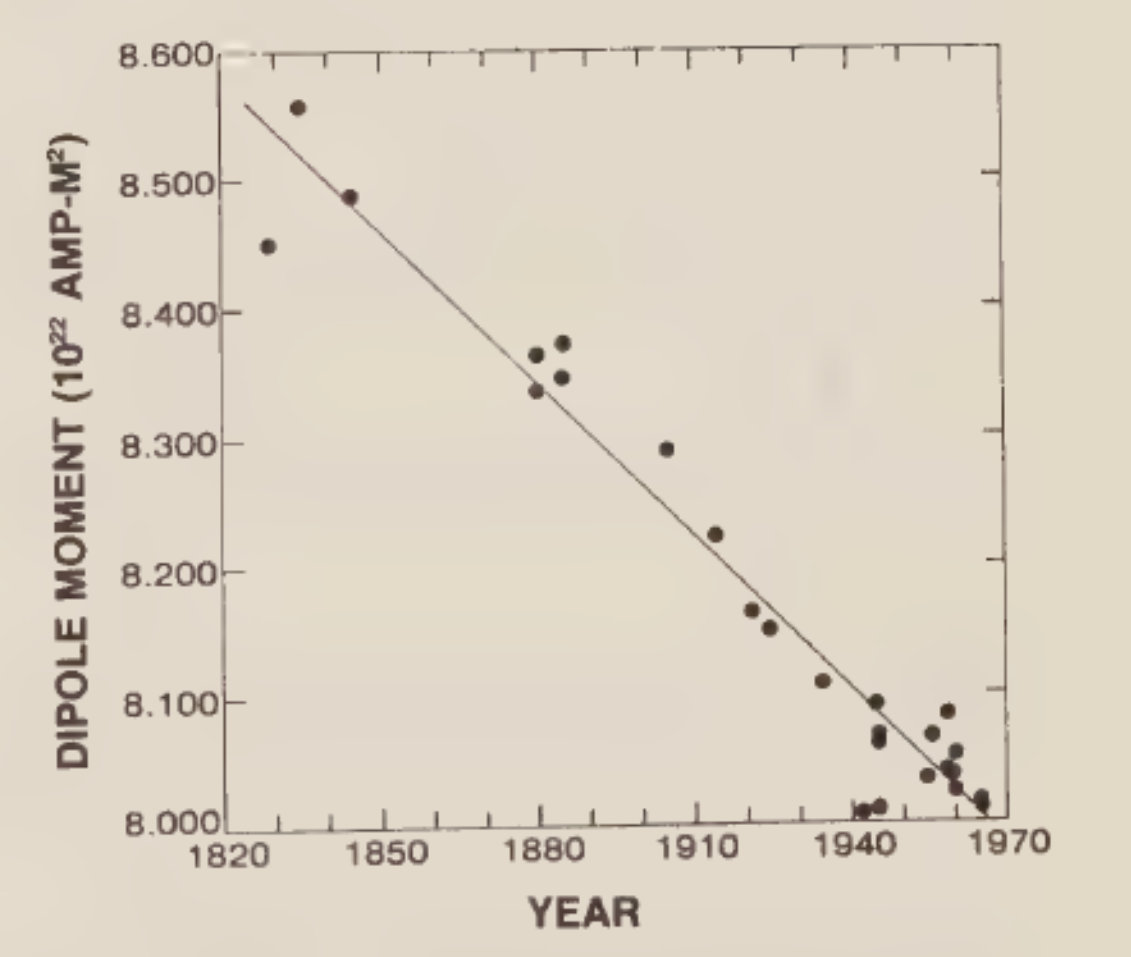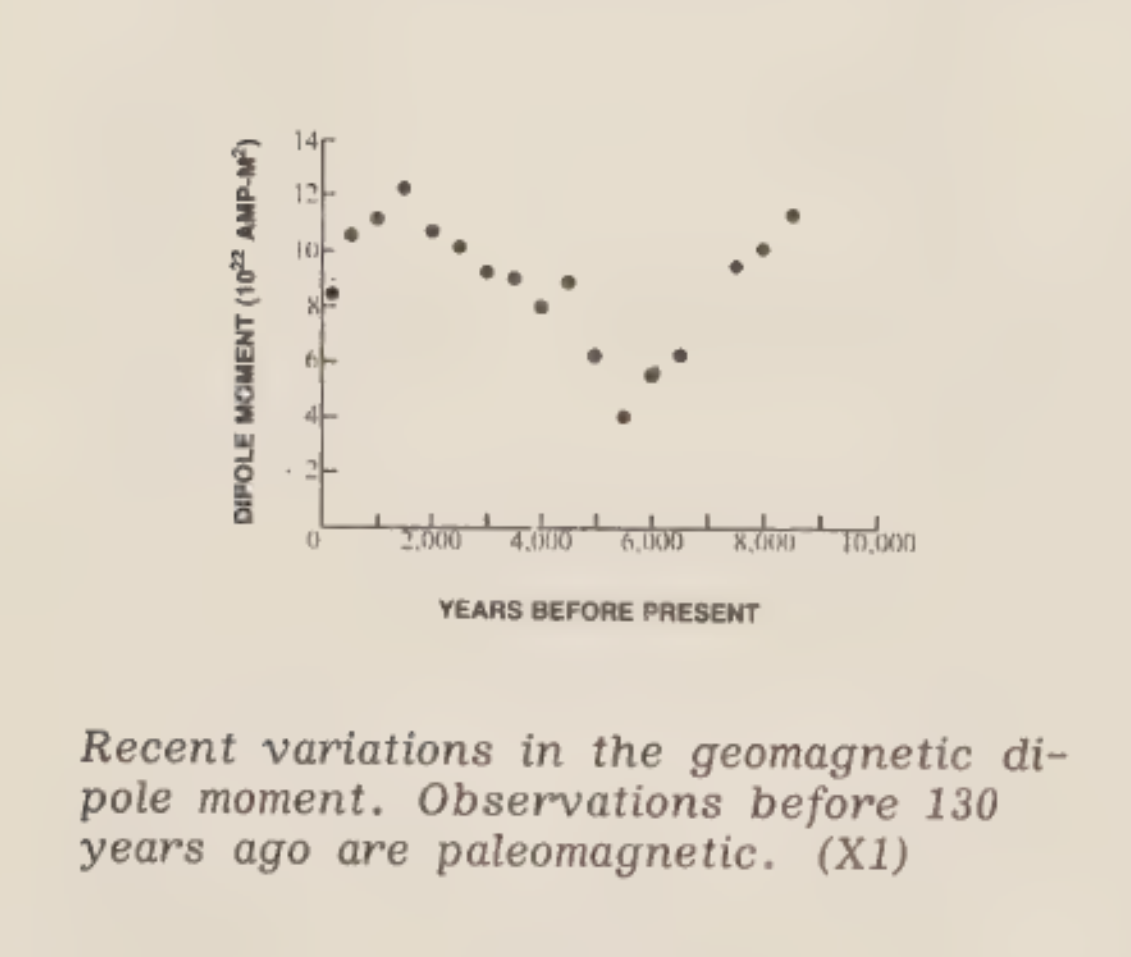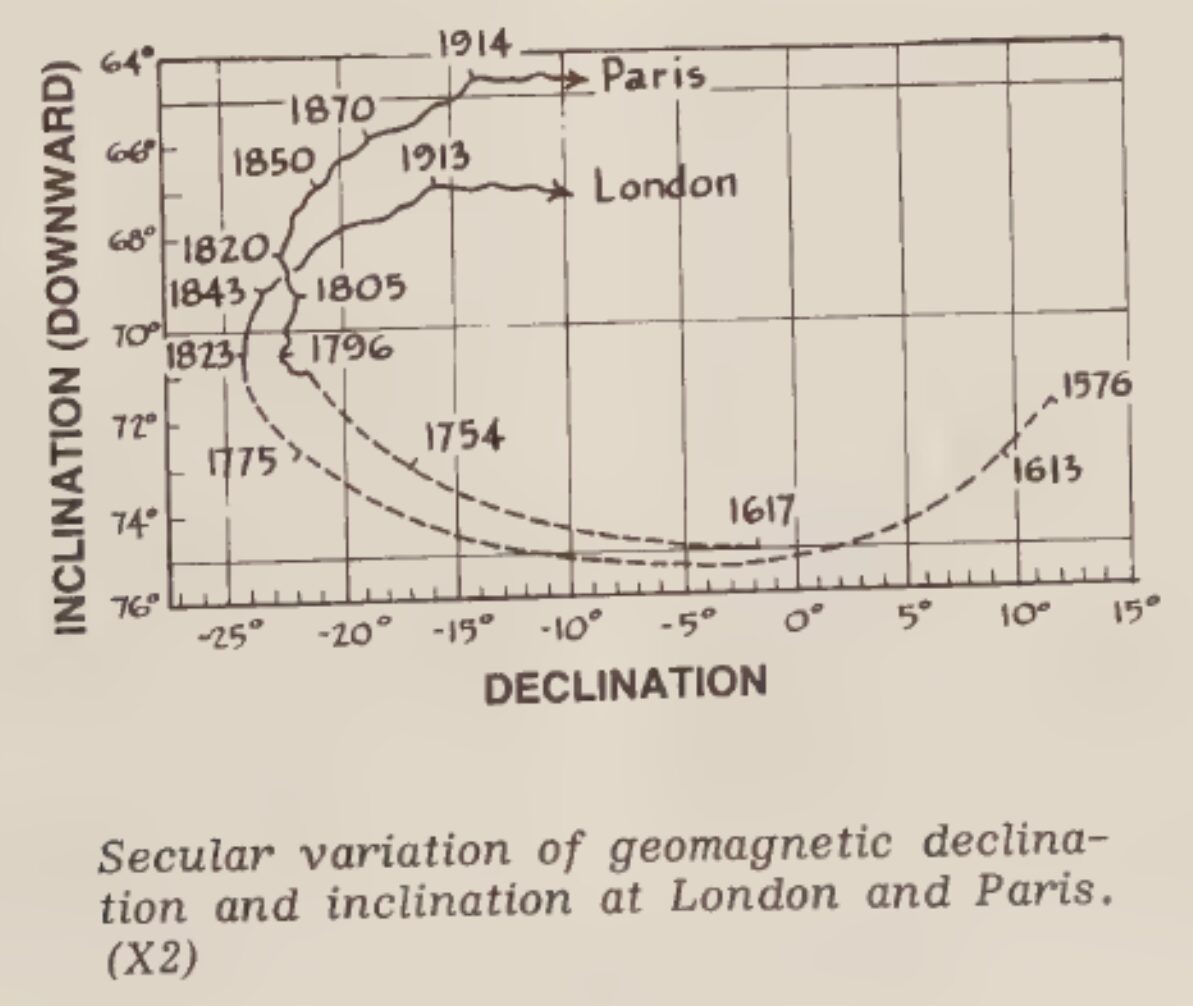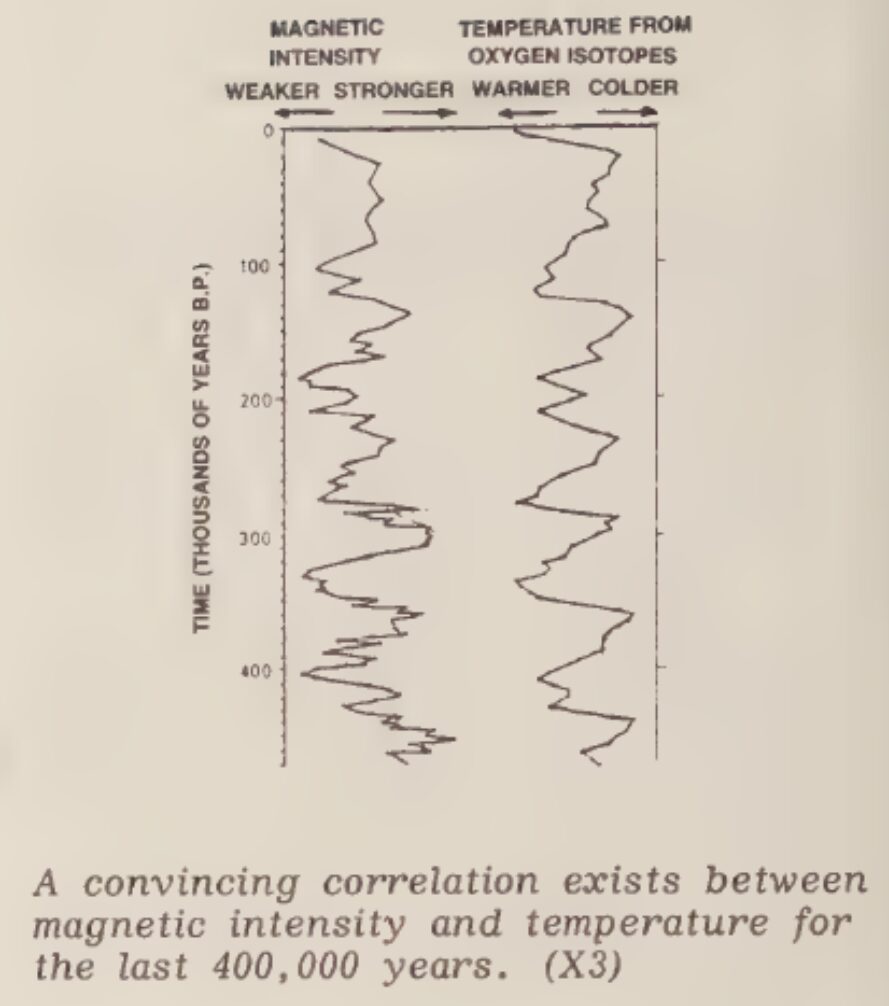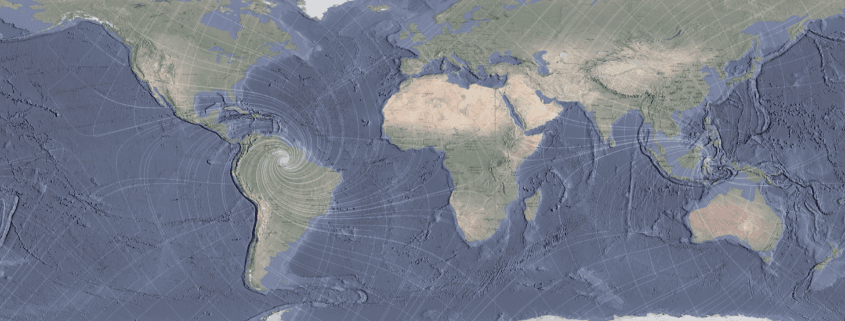EZF0
Introduction
It is accepted that the geomagnetic field resembles that of a dipole (or bar magnet) located at the earth’s center. This theoretical representation accounts for about 90% of the geomagnetic field and provides geophysicists with the familiar diagram showing magnetic lines of force exiting one polar region and entering the other. This neat portrait of the geomagnetic field is marred in practice by several important anomalies that cast doubt upon the almost universally accepted view that the geomagnetic field is a product of dynamo action.
First, the axis of the steady-state geomagnetic field does not lie parallel to the axis of rotation. Second, there exists a significant (10%) non-dipole field. Third, the non-dipole field is of complex structure and undergoes unpredictable secular changes, such as drifting, sudden acceleration, and shifts in configuration.
Despite these anomalies, the geodynamo theory is the only one that even comes close to explaining the observed configuration and variability of the geomagnetic field. The geomagnetic field’s axial tilt and secular variation are both difficult-to-account-for using the dynamo model, as are other geomagnetic observations. But, as if to compensate, the geodynamo’s shell of electrically conducting fluid, which is stirred by heat, forces of rotation, earthquakes, etc., offers many opportunities to explain complex phenomena. In other words, the potential complexity of the geodynamo matches the observed complexity of geomagnetic phenomena. Nevertheless, it does seem risky to rely so completely and uncritically upon a single theoretical concept.
EZF1
Anomalies of the Steady-State Geomagnetic Field
Description. Departures of the geomagnetic field from that of an ideal dipole positioned at the earth’s center and parallel to the planet’s axis of rotation.
Data Evaluation. General descriptions of the earth’s magnetic field abound in both scientific and popular literature. It is interesting to note, however, that the geographical positions given for the magnetic poles (the so-called “dip poles”) cover a wide range. Rating: 1.
Anomaly Evaluation. As detailed in X0, below, the dynamo theory of the origin of the geomagnetic field is almost universally accepted. The inclination of the geomagnetic field’s axis to the axis of rotation is incompatible with this theory. To retain the dynamo theory, small, additional dipoles and/or other changes in core configuration must be assumed. Further, the presence of large-scale geomagnetic anomalies requires similar “tuning” of the dynamo model. At present, no one seems to know just how “supplementary” dipoles and other such modifications would work physically. These anomalies seem all the more serious because geophysicists insist that the dynamo theory is the only viable one. Rating: 1.
Possible Explanations. Complex circulation patterns, perhaps even turbulence, may combine to cause the observed departures from the ideal dipole field, but these “band-aids” simply underscore our ignorance about chemical and physical processes transpiring beneath the crust. Other generators of magnetic fields may exist, such as thermoelectrically-driven electric currents and conducting fluids circulating well outside the core proper.
Similar and Related Phenomena. Secular changes (EZF2); extraterrestrially considered induced transients of the geomagnetic field. (The latter are not anomalous here.)
X0. Introduction and baseline theory. The fact of the earth’s magnetic field has been apparent for centuries, but its elucidation has been much more difficult than its detection. The geomagnetic field is rather weak when compared to magnets of human manufacture, but it is strong compared to the fields of the other terrestrial planets. At the equator, the total magnetic intensity is about 0.3 gauss. This increases to about 0.7 gauss in the polar regions. The geomagnetic field can be approximated by a dipole, located at the earth’s center, tilted about 11° to the axis of rotation. This tilting of the magnetic axis remains an anomaly — one that also prevails on some other solar-system planets. The “tilt” will be treated in X1 and X2. Another sort of anomaly becomes apparent when one subtracts the magnetic intensity calculated for the ideal dipole problem from the measured geomagnetic field.
These deviations (the “non-dipole” field) exhibit structures hundreds, even thousands of miles in extent. Such structures are termed “magnetic anomalies”; and here the use of the word “anomaly” is consistent with usage in the Catalog of Anomalies. These large-scale magnetic anomalies are covered in X3. See ESC for small-scale magnetic anomalies. One of the greatest problems in geophysics is the development of a mechanism that will generate the observed geomagnetic field with all its steady-state anomalies (ESF1) and the so-called secular changes (ESF2). This problem is deemed so important that an entire section (ESF3) is devoted to it. Three important facts severely constrain speculation about field-generating mechanisms; and they should be brought forward at the outset:
(1) The temperature of the earth rises rapidly as one drills down through the crust. By extrapolating these measurements, it can be asserted that at depths of just 100 kilometers or so, temperatures have surpassed the Curie point of known materials, and it is too hot for magnetism to exist.
(2) Secular changes of the geomagnetic field occur too rapidly to be accounted for by solid, permanently magnetized materials.
(3) The electrical resistance of core materials — as predicted from present models of the earth’s interior — is too high for the earth’s field to be generated by deep, still-circulating, primordial electrical currents, assuming that the earth is billions of years old. These restrictions do not preclude the generation of the geomagnetic field through dynamo action, thermoelectrically generated currents, or other on-going physical processes. See ESF3.
In most modern scientific books and papers, it is stated dogmatically that the dynamo theory is the only viable theory. This is an extreme statement in the light of the difficulties the geo-dynamo theory encounters. It is safer to hedge a bit, as in the following quotation from H. Takeuchi et al:
“What is the origin of the geomagnetic field? Many a hypothesis has been offered and rejected. The fairest answer at present would be that the geo-magnetic field is caused by electric currents within the core, and that these currents are probably induced and maintained by a mechanism such as the self-exciting dynamo. The dynamo theory is certainly by far the best yet offered. It is not perfect, but it surpasses all others by a wide margin.” (R3)
As users of the Catalog of Anomalies might surmise, the compiler ventures that we do not yet know enough about deep-earth processes to restrict ourselves dogmatically to the geodynamo model.
X1. The tilt or inclination of the axis of the geomagnetic field to the earth’s axis of rotation. It is not difficult to determine the earth’s axis of rotation from astronomical measurements; the precise position of the geomagnetic axis is more difficult to locate. In principle, one can locate the geomagnetic poles either by finding the two spots, north and south, where the compass needle (actually an inclinometer here) points straight down or by pinpointing the spots where northerly and southerly compass readings converge.
In practice, however, neither procedure is very accurate due to the erratic behavior of compasses in the polar regions. Wildly different pole positions may be found in the literature, as recorded in X2. Alternatively, one can combine aircraft and satellite magnetic measurements and determine the inclination of the dipole that best fits them. In this way, geophysicists have decided that 90% of the geomagnetic field is dipolar in nature, and that the dipole representing this part of the field is inclined 11° to the axis of rotation. (R13; R3, R11, R12, R14)
The tilt of the earth’s magnetic field and those of the other planets (especially Uranus, 60°; and Neptune, 47°) seriously challenge the dynamo theory of field generation, since this theory relies on the planet’s rotation. (See ESF3.) The way in which geophysicists deal with the tilt anomaly, as well as other anomalies of the geomagnetic field, is to suppose there are secondary dipole fields created at “spots” near the surface of the liquid core. S. Akasofu and T. Saito, for example, think that two or three such extra dipoles effectively tilt the magnetic fields of all the planets afflicted by this divergence of axes. In their theory, the axis of the main dipole field remains parallel to the axis of rotation, but the secondary dipoles warp the total field. (R11, R12, R14)
K. Whaler has objected that there exists no known physical mechanism for creating such secondary dipoles near the liquid core’s surface. (R12)
It may be possible to conceive of complex circulation patterns in the earth’s liquid core that can account for just about any distortion of the basic dipole field. But then one must explain the complex circulation patterns! It might be better, but not necessarily easier, to search for other ways in which the geomagnetic field might be generated. (WRC)
X2. Is the geomagnetic axis offset? In the preceding discussion of the tilted geomagnetic axis, it was tacitly assumed that this axis went through the center of the earth, where it intersected the axis of rotation. If the geomagnetic axis were offset as well as nonparallel to the axis of rotation, the dynamo theory would be in additional difficulty. The only evidence that an offset axis might be a reality arises from the great discrepancies in the published positions of the geomagnetic poles, as in the accompanying table. As mentioned earlier, accurate location of the poles with compasses is a daunting task. Even so, the range of quoted values is very large. entries from R3, in fact, were aparently computed from the accepted 11° tilt of the ideal dipole, for the poles are precisely 180° apart. In other words, they were not located from the ground by compasses but rather from the position of the ideal dipole. But the other values allow the possibility of an offset or possibly a “crooked” geomagnetic axis.
| NMP Latitude | NMP Longitude | SMP Latitude | SMP Longitude | Reference |
|---|---|---|---|---|
| — | 96°W | — | 155°E | R1 |
| 78.5°N | 69°W | 78.5°S | 111°E | R3 |
| 77°N | 102°W | 65°S | 139°E | R9 |
| 77.3°N | 101.8°W | — | — | R16 |
| 76.1°N | 100°W | 65.8°S | 139°E | R17 |
In 1930, O.J. Lee published a letter in Science pointing out the possibility of offset poles and appending a catastrophic interpretation.
“A remarkable asymmetry exists in the longitude of the earth’s magnetic poles, which are at present [1930] in 96° west and 155° east longitudes. They are, therefore, only 109° apart, and their longitudes mark out roughly the average boundaries of the Pacific Ocean, the vast basin of which has many ‘deeps’ and is enclosed by a giant circlet of extinct and active volcanoes. If this basin is the birthplace of the moon, it does not seem unreasonable to expect that enough of the heavier, deep-lying magnetic elements in the earth may have been torn along, placenta-wise, on that natal occasion to actually fix the magnetic poles of the earth in these regions. Perhaps it would be better to say that when the lunar material departed, a shift in the distribution of magnetic materials within the remaining mass took place toward the Pacific basin.” (R1)
This non-antipodal arrangement of the earth’s magnetic poles was widely accepted in the 1930s and was even associated with the onset of continental drift. (R2) Today, however, the possibility of an offset or crooked geomagnetic axis is rarely considered. Any evidence for such situations is explained away as distortion of the dipole field due to secondary dipoles on the core surface. (WRC)
X3. Large-scale, non-dipole aspects of the geomagnetic field. The non-dipole geomagnetic field (sometimes called the “seomagnetic anomaly”) is what remains after the dipole field has been subtracted out. Some large-scale departures from the dipole field are obvious. (R3)
Thousands of miles in extent, these magnetic anomalies dwarf the much smaller anomalies tendered in EZC. About all that can be said about these large-scale anomalies in the way of explanation is that they are “probably” due to structures deep within the earth, whereas the small-scale EZC anomalies are superficial. It is possible, however, that these “structures” may derive from the geodynamo itself.
A new perspective on large-scale magnetic anomalies has been drawn by J. Bloxham and D. Gubbins. Their technique involves mathematically projecting surface measurements of the geomagnetic field down to the surface of the earth’s liquid core, where the field is thought to originate. To do this Bloxham and Gubbins must make assumptions about the physical properties of the crust and mantle, such as their electrical conductivities. By using past measurements of the geomagnetic field, they can chart recent changes on a global basis.
The field at the core’s surface shows areas of strong departure from the dipole field. For example, an especially strong concentration of flux exists at the core surface positioned below the South Atlantic Ocean. More startling is the suggestion by Bloxham and Gubbins that the surface dipole field actually derives from four “patches” on the core surface. The magnetic fluxes from these patches combine at the surface to give the “illusion” of a mainly dipole field! (R8, R15) If the calculations of Bloxham and Gubbins are correct, and these patches are real, the geodynamo must be configured accordingly. (WRC)
References
R1. Lee, Oliver J.; “The Magnetic Poles of the Earth and the Birth of the Moon,” Science, 72:89, 1930. (X2)
R2. Longfellow, D.W.; “The Magnetic Poles of the Earth and the Birth of the Moon,” Science, 72:424, 1930. (X2)
R3. Takeuchi, H., et al; “The Mystery of the Earth’s Magnetism,” Debate about the Earth, San Francisco, 1967, p. 94. (X1-X3)
R4. Carrigan, Charles R., and Gubbins, David; “The Source of the Earth’s Magnetic Field,” Scientific American, 240:118, February 1979. (X0)
R5. Mulholland, Derral; “When North Becomes South,” Mosaic, 13:2, September/October 1982. (X0)
R6. Busse, F.H.; “Recent Developments in the Dynamo Theory of Planetary Magnetism,” Annual Review of Earth and Planetary Sciences, 11:241, 1983. (X0)
R7. Jacobs, J.A.; “Magnetism and the Evolution of the Terrestrial Planets,” Nature, 305:582, 1983. (X0)
R8. Gubbins, David, and Bloxham, Jeremy; “Morphology of the Geomagnetic Field and Implications for the Geodynamo,” Nature, 325:509, 1987. (X3)
R9. Patten, Donald Wesley; “The Origin and Decay of the Earth’s Geomagnetic Field,” Catastrophism and Ancient History, 9:91, 1987. (X2)
R10. Hoffman, Kenneth A.; “Ancient Magnetic Reversals: Clues to the Geodynamo,” Scientific American, 258:76, May 1988. (X3)
R11. Eberhart, J.; “Straightening the Magnetic Tilts of Planets,” Science News, 137:294, 1990. (X1)
R12. Bowler, Sue; “A Simple Model for Planets’ Magnetic Fields?” New Scientist, p. 32, June 16, 1990. (X1)
R13. Merrill, R.T., and McFadden, P.L.; “Paleomagnetism and the Nature of the Geodynamo,” Science, 248:345, 1990. (X1)
R14. Akasofu, S., and Saito, T.; “Is the Earth’s Dipole Actually Inclined with Respect to Its Rotation Axis?” Eos, 71:490, 1990. (X1)
R15. Bloxham, Jeremy, and Gubbins, David; “The Evolution of the Earth’s Magnetic Field,” Scientific American, 261:68, December 1989. (X3)
R16. Dalrymple, G. Brent; “Can the Earth Be Dated from Decay of Its Magnetic Field?” Journal of Geological Education, 31:124, 1983. (X1, X2)
R17. Cain, Joseph C.; “Geomagnetism,” McGraw-Hill Encyclopedia of Science and Technology, 6:154, 1977. (X0-X2)
EZF2
Secular Variations of the Geomagnetic Field
Description. Changes in the parameters describing the geomagnetic field on a time scale of a year or more. The parameters usually involved are those of the non-dipole field and may include the formation, change-in-shape, and geographical movement of patches of flux and other structures of the non-dipole field.
Data Evaluation. Over a century’s worth of high-quality geomagnetic measurements are available. Rating: 1.
Anomaly Evaluation. The overall impact of the whole panoply of secular variations of the geomagnetic field is that the phenomena are extremely complex in terms of time, geography, and radial location (earth’s surface or core-mantle boundary). The anomalousness of each aspect of secular variation depends upon how well the reigning dynamo theory can accommodate the complexities. Seeing that the electrically conducting fluid of the geodynamo can exhibit eddies, internal waves, convection cells, turbulence, and even chaotic motion, we have at hand a field-generating mechanism that may be up to almost any assigned task! Therefore, we cannot assign a high anomaly rating here. Rating: 3.
Possible Explanations. As above. See also ESF3 for other theories of the geomagnetic field.
Similar and Related Phenomena. The decay of the geomagnetic field (EZF1); pole wandering (EZP3); paleomagnetism correlated with climate changes (EZP5).
X0. Introduction. “Secular variations” of the geomagnetic field occur on a scale of roughly a year or more, shorter-scale variations being termed “transients”. In geophysical parlance, “secular variation” is primarily applied to the slow westward drift of certain features of the geomagnetic field, such as the lines of equal declination. However, there are other secular variations, like the historical decay of the magnetic moment of the geomagnetic field. This broader interpretation of the word “secular” is employed here.
X1. The historical decay of the geomagnetic field. Measurements of the magnetic moment of the dipole component of the geomagnetic field since 1835 show a steady decrease of about 0.05% per year. (R26) This amounts to 5% per century and is a large change for a geophysical variable storing so much potential energy. The implication is that if this rate of decay persists, the earth’s magnetic field will vanish in only 2000 years or so. The undeniable trend raises important scientific and practical questions.
Will this decay of the field continue? Of course, no one can predict the future with certainty: the trend may reverse; the geomagnetic field may become null and then reverse polarity; or the field may even disappear permanently. In this situation, an appeal to archeomagnetic measurements involving dated pottery has assures us that the geomagnetic field had its ups and downs over the last several thousand years. In other words, secular decreases have happened before. (RT, R23) In fact, the present geomagnetic field is much stronger than it has been, on the average, over the long term. (R26) Looking backwards in time ever farther, paleomagnetic research tells us that a geomagnetic field existed as far back as 2.7 billion years ago. (R14) In addition, outright reversals of the field seem to have occurred frequently over geological time. (See EZP.) All things taken, it is likely that the geomagnetic field will either increase in strength or decay through zero and change polarity. The history of the geomagnetic field does not imply its complete disappearance, despite creationist claims to the contrary. (R3) From the viewpoint of the anomalist, however, the decay of this fundamental variable is very important, for we do not know why it is occurring at all and, particularly, why it is happening so fast.
Is the decay of the geomagnetic field real? This question is more subtle than it appears. Geophysicists are agreed that the dipole component (presently 90% of the field) is definitely decreasing. But G.B. Dalrymple points out that the non-dipole component (presently 10%) has been increasing enough to almost compensate for the waning dipole component. In effect, the geomagnetic field seems to be becoming less and less “dipolish”. Perhaps even more important is that portion of the geomagnetic field that we cannot measure directly — that part well below the earth’s crust. (R14) This “hidden” magnetic energy could even be increasing!
The “young earth” claim of the scientific creationists, notably T.G. Barnes, maintain that the geomagnetic field is actually generated by a powerful electric current that was conferred when the earth was created rather than by dynamo action. In this view, the decay of the geomagnetic field is simply the consequence of this primordial electric current decreasing due to the internal electrical resistance of the planet’s materials. According to Barnes, the field has been decaying exponentially with time. When the geomagnetic field prevailing 10,000 years ago is computed on this basis, using the historical trend, it turns out to be ridiculously large. The earth, then, must be less than 10,000 years old! (R2, R3, R9, R11, R13-R15, R18, R20-R24) The implications of archeomagnetism and paleomagnetism seem to have been ignored by the creationists.
G.B. Dalrymple has written a long paper refuting the claims of the scientific creationists. These claims really rest upon the assumption that a primordial electric current was created with the earth by fiat. This current is postulated because of the lack, according to the creationists, of a viable geodynamo model. Although the geodynamo model has its problems (See ESF3.), it seems to have a better chance of explaining the past ups and downs of the geomagnetic field, the field’s westward drift, its transients, and the complex structure of the non-dipole field than a steadily decaying primordial electrical current. (R14) In other words, although a circulating electric current could generate the geomagnetic field, it cannot account for the field’s temporal and geographical characteristics; and, of course, there is evidence that the earth’s field existed over a billion years ago. (WRC)
Practical consequences of a zero geomagnetic field. The geomagnetic field for all its vicissitudes is a reliable shield against the energetic charged particles comprising solar and galactic cosmic rays and the solar wind. Long-term removal of this shield could be devastating to the biosphere. Actually, some scientists have suggested that the biological extinctions in the fossil record could have been caused by zero-field episodes occurring, perhaps, during polarity reversals. See ESB.
X2. Drift and changing structure of the non-dipole field. The non-dipole field, as characterized by maps of equal declination, equal inclination etc. is not static. The features of these maps drift across the globe, rotate, change form, and wax and wane. Whatever generates the total geomagnetic field — the geodynamo or some unrecognized mechanism — must be able to account for these secular changes. The manifest complexity of the changing non-dipole field implies a similar complexity in the structure of the main geodynamo and, perhaps. secondary “dynamos. The same is true for any other proposed mechanisms of field generation. One must admit that the motions of a fluid, metallic core could mimic the complexity of the measured geomagnetic field.
The anomaly in this situation is that we just don’t know exactly how the favored dynamo model can account for all the subtleties of the field. The problem is made more difficult by the sudden changes in the panorama of the secular variations introduced in X6, below.
The westward drift of some features of the non-dipole field. Early students of the geomagnetic field soon noticed that he magnetic declination and inclination at specific locations changed rather rapidly, as shown in the accompanying graph for London and Paris. The overall effect of such changes, in recent years, is an apparent westward drift of the non-pole field. H. Takeuchi et al describe the phenomenon in the following paragraph.
“It is as though we were looking at a revolving light on the shade of which the geomagnetic anomaly has been mapped. The rate of westward drift is about 0.18° in longitude per year; at that rate, the pattern should go around the earth in approximately 2000 years. The speed of westward drift is significant. Unlike magnetic storms which arise from external causes, the large-scale geomagnetic anomalies and their westward drift must be caused within the earth. Generally, changes within the earth occur very slowly, encompassing millions and even billions of years; two thousand years is a very short time in comparison. Indeed, this is an important key to the explanation of the earth’s magnetism…” (R3)
The westward drift of the non-dipole field has been ascribed to: (1) slippage between the liquid core and the mantle; and (2) wave motion of fluids in the core. Unfortunately for these appealing theories, the westward drift now seems to be confined mainly to the Atlantic hemisphere, 90°W to 90°E longitude. In this hemisphere, some features move as much as 10 kilometers per year, but in the Pacific hemisphere westward drift all but ceases, (R25)
Ephemeral features of the non-dipole field. In addition to the westward drift phenomenon (geographically limited though it may be), some of the mapped features of the non-dipole field form, grow, change configuration, and decay on a timescale of hundreds of years, as one can see from historical records of the field measured at the Earth’s surface. As described in EZF1, J. Bloxhman and D. Gubbins may have found a way to accurately map similar features deep down at the core-mantle boundary. Some of the things they have found in their analysis of about 300 years of observations are:
- Rapidly drifting flux spots in the Southern Hemisphere that drift westwards from around 90°E towards South America
- Intense static flux bundles under Arctic Canada, Siberia, and Antarctica
- Static, near-zero-flux patches under the North Pole, under Easter Island, under the northern Pacific Ocean, and possibly under the South Pole. The polar patches are surprisingly near the poles where the dipole field should be of maximum intensity. (R19, R25)
Quite obviously, we are not dealing with a simple phenomenon here. (WRC)
X3. Correlation of geomagnetism and climate. Causal connections between the earth’s magnetic field and climate are not easy to imagine. It is therefore understandable to find a certain reluctance among scientists to accept the correlations reviewed below. A pioneer in searching out correlations between geomagnetism and climate has been G. Wollin. Wollin has looked at many of the variables employed in describing the magnetic field and climate to see which, if any, vary in step with one another, perhaps even with a time lag between them. The two pertinent bodies of data are:
(1) almost 300 years of direct measurements of the geomagnetic field and climate parameters;
(2) paleomagnetic and paleoclimatological data stretching back for millions of years. Both bodies of data produce intriguing correlations, providing the right variables are chosen for comparison. See also EZP5-X4 for the “paleo” correlations.
The “recent” correlation. Wollin’s attempt to correlate recent magnetic data with climate met with scant success until he found a link between the rate-of-change of magnetic intensity and sea-surface temperature. Further, this correlation became convincing only when a three-year delay was assumed between the increases in the rate-of-change of magnetic intensity and increases in sea-surface temperature. Again, the physical mechanism proposed is rather involved: (1) magnetic changes induce motion in the ionosphere; (2) these are coupled to the lower atmosphere and oceans in a complex feedback loop that ends with a rise in sea-surface temperature; and (3) sea-surface temperatures affect climate/weather with a three-year lag. (R10)
X4. Geomagnetic fluctuations potentially correlated with weathering processes. We have here only a weak possibility that a correlation exists, as seen, perhaps, in such geological features as concentrically banded spheroidal weathering patterns. The possible connecting mechanism is explained below by R.J. Fleisher.
“The correlation of geomagnetics with organic weathering lies in the fact that various forms of life show a sensitivity to magnetic forces, with changes in ambientlike conditions causing involuntary modification of life functions in some species of lower life forms. Should similar effects influence suggested by Sisler microorganisms, as and Seuffle, Becker, Palmer, Bairamova and Aliev, and Blakemore, their role in the weathering regime may be sufficiently altered to cause variations in weathering products and patterns.” (R5)
X5. Historical measurements of polar wandering. The subject of polar wandering will be treated in greater depth in EZP3, in connection with paleomagnetic anomalies, but it is worthwhile noting here that the positions of the magnetic poles have changed quite rapidly in the past 150 years. G.B. Dalrymple elaborated as follows.
“Secular variation results in changes in the location of the earth’s magnetic, or dip, poles. The dip poles are those points on the earth where a freely suspended compass needle points straight down. The dip poles move much more rapidly than the poles of the dipole field. Today, for example, the north magnetic pole is located not at the north geographic pole (latitude 90 degrees N.), but at latitude 77.3 degrees N., longitude 101.9 degrees W. In 1831, however, when Commander James C. Ross found and claimed the north magnetic pole for Great Britain, the pole was located at latitude 70.1 degrees N., longitude 96.8 degrees W. Thus, the north magnetic pole has moved about 800 kilometers in the past 150 years.” (R14)
The rapid motion of the dip poles must somehow be encompassed by the geodynamo theory; otherwise, an anomaly exists.
X6. Secular variation impulses or magnetic “jerks”. The major component of the secular variation of the earth’s non-dipole field is its westward drift. Superimposed upon the general drift are sudden accelerations on a time scale of roughly one year. Such “jerks” were discovered through the analysis of magnetic measurements from many magnetic observatories worldwide.
“Secular variation of the geomagnetic field observed at the Earth’s surface has been found to undergo rapid accelerations lasting less than a few years, a much shorter duration than had previously been recognized for signals generated in the Earth’s core and having diffused through the electrically-conducting mantle. One such rapid and worldwide acceleration occurred in 1969; an earlier, a less well documented acceleration apparently occurred around 1913.. The identification of these events was made possible by carefully assembled long data sets from magnetic observatories around the world.” (R17)
Some geophysicisis have been very skeptical about the real nature of the 1969 jerk. For one thing, this magnetic impulse was not discerned everywhere. In some parts of North America, the magnetic records show nothing; elsewhere the event is not well-defined. Nevertheless, the phenomenon was very distinct in many widely separated localities. (R28, R29).
Such short-term changes were previously thought to be impossible for geodynamo-generated fields. While short-period variations in the geomagnetic field (transients) do occur, these are linked to currents flowing in the ionosphere and are, therefore, of external origin; viz., solar-generated charged particles. [These transients and magnetic storms are not considered anomalous and are not covered in the Catalog of Anomalies.] The time-scale boundary between geo-dynamo-created secular variations and sun-generated transients was thought to be from 4-10 years before the “jerks” were observed. (R17)
Theorists are hard put to conceive of geodynamo instabilities that would produce a magnetic jerk observable on the earth’s surface through the “insulation” provided by the crust and mantle. One idea is that bubbles grow and migrate in the core. Another suggestion involves the “twisting” of core fluid as the fluid rotates and convects toward the core surface. (R26)
Changes in the pattern of secular variation also occur on a smaller geographical scale. H. Mizuno analyzed 12 years of magnetic data from 40 Japanese stations and found abrupt changes at several. These smaller disturbances did not appear to be related to one another or to the 1969 “jerk”. (R28)
The earth’s core, if it does constitute the geodynamo, as almost everyone contends, is a very turbulent entity with its own “weather”. It should be recognized that surface-confined geophysicists can detect only those changes that have the strength to diffuse upward through the 2900-kilometer, partially insulating crust and mantle. The geomagnetic field at the core-mantle boundary is doubtless more dynamic and disturbed than we now perceive. It could, in fact, be capable of chaotic behavior. (WRC)
References
R1. Takeuchi, H., et al; “The Mystery of the Earth’s Magnetism,” Debate about the Earth, San Francisco, 1967, p. 94. (X1-X3)
R2. Barnes, Thomas G.; “Young Age vs Geologic Age for the Earth’s Magnetic Field,” Creation Research Society Quarterly, 15:5, 1978. (X1)
R3. Barnes, Thomas G.; “Origin and Destiny of the Earth’s Magnetic Field,” ICR Technical Monograph No. 4, 1973. (X1) ICR = Institute for Creation Research
R4. Melvin, Goesta, et al; “Magnetic Intensity and Climate Changes 1925-1970,” Nature, 242:34, 1973. (X3)
R5. Fleischer, R.L.; “Is There a Correlation between Geomagnetic Fluctuations and Weathering Processes?” Geology, 4:702, 1976. (X4)
R6. Carrigan, Charles R., and Gubbins, David; “The Source of the Earth’s Magnetic Field,” Scientific American, 240:118, February 1979. (X0)
R7. Games, Ken; “Short Period Fluctuations in the Earth’s Magnetic Field,” Nature, 277:640, 1979. (X1)
R8. Mäkisara Down; “Magnetic Field Declining,” Science News, 117:407, 1980. (X1)
R9. Barnes, Thomas G.; “Satellite Observations Confirm the Decline of the Earth’s Magnetic Field,” Creation Research Society Quarterly, 18:39, 1981. (X1)
R10. Gribbin, John; “Geomagnetism and Climate,” New Scientist, 89:350, 1981. (X3)
R11. Barnes, Thomas G.; “Depletion of the Earth’s Magnetic Field,” ICR Impact Series No. 100, October 1981. (X1)
R12. Tarling, D.H.; “Geomagnetic Cores and Secular Effects,” Nature, 296:394, 1982. (X1, X2)
R13. Barnes, Thomas G.; “Earth’s Magnetic Age: The Achilles Heel of Evolution,” ICR Impact Series No. 122, August 1983. (X1)
R14. Dalrymple, G. Brent; “Can the Earth Be Dated from Decay of Its Magnetic Field?” Journal of Geological Education, 31:124, 1983. (X1)
R15. Barnes, Thomas G.; “Earth’s Young Magnetic Age: An Answer to Dalrymple,” Creation Research Society Quarterly, 21:109, 1984. (X1)
R16. Gire, C., et al; “Evolution of the Geomagnetic Secular Variation Field from the Beginning of the Century,” Nature, 307:349, 1984. (X6)
R17. Courtillot, V., and Le Mouel, J.L.; “Geomagnetic Secular Variation Impulses,” Nature, 311:709, 1984. (X6)
R18. Taylor, Ian T.; “Earth’s Decaying Magnetic Field,” In the Minds of Men, Toronto, 1984, p. 331. (X1)
R19. Bloxham, Jeremy, and Gubbins, David; “The Secular Variation of the Earth’s Magnetic Field,” Nature, 317:777, 1985. (X1, X2)
R20. Barnes, Thomas G.; “Earth’s Young Magnetic Age Confirmed,” Creation Research Society Quarterly, 23:30, 1986. (X1)
R21. Schadewald, Robert; “Creationist Pseudoscience,” in Science Confronts the Paranormal, Kendrick Frazier, ed., Buffalo, 1986, p. 313. (X1)
R22. Chaffin, Eugene F.; “A Young Earth Survey of Dating Methods,” Creation Research Society Quarterly, 23:109, 1986. (X1)
R23. Humphreys, Russell; “The Mystery of the Earth’s Magnetic Field,” ICR Impact Series No. 188, 1989. (X1)
R24. Barnes, Thomas G.; “Dwindling Record of a Young Earth,” Creation Research Society Quarterly, 25:170, 1988. (X1)
R25. Bloxham, Jeremy, and Gubbins, David; “The Evolution of the Earth’s Magnetic Field,” Scientific American, 261:68, December 1989. (X1, X2)
R26. McElhinny, M.W., and McFadden, P.L.; “Paleomagnetism and the Nature of the Geodynamo,” Science, 248:345, 1990. (X1, X2)
R27. Kerr, Richard A.; “From One Coral Many Findings Blossom,” Science, 248:1514, 1990. (X1)
R28. Kerr, Richard A.; “Magnetic ‘Jerk’ Gaining Wide Acceptance,” Science, 225:1135, 1984. (X6)
R29. Weisberg, Stef; “The Earth’s Magnetic Hiccup,” Science, 128:218, 1985. (X6)
EZF3
Problems of Geomagnetic-Field Generation
Description. Theoretical and practical objections to the favored geodynamo hypothesis and other schemes that have been proposed for the osurce of the geomagnetic field.
Data Evaulation. Much has been written pro and con about the geodynamo theory. The bulk of the discussions in the literature, though, uncritically accept the premise that the geodynamo theory is the only physically viable possibility. Little effort seems to have been made to explore radical, speculative concepts. Rating: 2.
Anomaly Evaluation. In contrast to most entries in the Catalog of Anomalies, we deal here with theories rather than anomalous observations. The importance of establishing the source of the geomagnetic field makes it worthwhile to deviate momentarily from our concentration upon observables. The anomalies that cause geophysicists to question the geodynamo theory have already been recognized in EZF1 and EZF2. The additional “difficulties” noted below merely accentuate the seriousness of the situation. Rating: 1.
Possible Explanations. None required since the focus is on theory rather than observations.
Similar and Related Phenomena. None.
X1. The geodynamo theory. Virtually all scientists in all fields assume that the geodynamo theory is the only viable one — and our reviews of the literature confirm this. Not that some are not uneasy about the geodynamo theory; it is the apparent lack of reasonable alternatives. Geophysicists range in their level of confidence from J. Bloxham and D. Gubbins, who assure us that: “The basic characteristics of the geodynamo have been known since the 1950s“; (R9) to a more sobering evaluation by R.T. Merrill and P.L. McFadden:
“Although there does seem to be a strong consensus that ‘the dynamo model picture’ for the Earth’s magnetic field is correct, there are in fact many dynamo models, none of which has been demonstrated to work for the Earth, and each of which is incomplete in some manner or another. The problem is very difficult because, for even an approximate solution, there are several coupled nonlinear partial differential equations that must be solved simultaneously. Furthermore several of the critical parameters are effectively unknown (e.g the viscosity of the Earth’s core is not known within several orders of magnitude). Overall, we appear to be far from obtaining a complete solution.” (R7)
The problems afflicting the dynamo theory are several. The preceding entries (EZF1, EZF2) have presented the complexities of the internally generated geomagnetic field in terms of time, configuration, and geography. Since doubts exist as to just how the simple, “basic” dipole field is generated, the situation worsens when the subtleties of the non-dipole field are considered. Beyond the problems of complexity lie two additional problem areas: (1) the source of the initial magnetic field required to start up a self-excited dynamo; and (2) the source of the energy that keeps the geo-dynamo going once started.
The initial magnetic field. A self-excited dynamo requires a separately supplied magnetic field to get it started. The separate field need not be large — just enough to “prime the pump”, so to speak. Two suggested sources of this field are: (1) thermoelectric currents in the mantle; and (2) the solar magnetic field, which extends throughout the solar system. (R1)
The geodynamo’s source of energy. The hypothetical geodynamo needs about 8×108 watts of power to keep it operating at its present level. (R5) This power required to sustain the geomagnetic field eventually manifests itself as heat in the liquid, electrically conducting core. Opinions differ as to the source of this power. Initially, in the geodynamo theory, this power is expressed in the motion of the core fluid (convection, turbulence, etc.). Several ways have been suggested for setting the core fluid into motion:
- Heat from disintegrating radioactive materials. Unfortunately, meteoric iron, which we would expect to be similar in composition to the earth’s liquid core, does not contain enough radioactivity to run the geodynamo. (R1)
- Relict heat from the earth’s formation. G.B. Dalrymple states that, over the past 3 billion years, a temperature drop of only 100°C in the core would have been sufficient to keep the geodynamo going. (R5)
- The earth’s rotation, as manifested in precessional motion and convection in the core. (R1, R2, R5)
- Seismic energy communicated to the core. (R3)
- Gravitational energy supplied through chemical differentiation as heavier materials sink and lighter ones rise. (R4, R5, R10)
- Heat evolving from liquid-to-solid phase changes. (R1)
- Impact energy from asteroids, comets, etc. Obviously, immense impacts would be required to transmit sufficient energy to the deep core. (R8) Today’s general consensus seems to be that most of the geodynamo’s power is derived from heat (both relict and radioactive) and the earth’s rotation. However, all of the listed possibilities, except #7, may be involved.
X2. Other mechanisms for generating the geomagnetic field. Some creationists claim that the geomagnetic field arises from a primordial electrical current still circulating in the core. (See EZF1.) Since this scenario implies an earth younger than about 10,000 years, it is not taken seriously in scientific circles. In considering other possible sources of the earth’s field, it should be re-emphasized that permanently magnetized geological material cannot be considered because: (1) core and mantle temperatures higher than the Curie point preclude permanent magnetization; and (2) the dynamic characteristics of the geomagnetic field are incompatible with solid, permanent magnets, unless they were somehow entrained in a cold slurry or some other improbable system. The only other possible source for the field mentioned in the literature surveyed is thermoelectricity generated by unidentified thermoelectric couples in the earth. (R1) No elaboration of this idea has yet been found.
The seeming absence of other acceptable alternatives to the geodynamo theory explains its popularity. The only path remaining is to postulate some still unrecognized physical phenomenon. Thus, we arrive at an impasse. The geodynamo theory possesses several grave faults, but no reasonable substitutes exist. (WRC)
References
R1. Takeuchi, H., et al; “The Mystery of the Earth’s Magnetism,” Debate about the Earth, San Francisco, 1967, p. 94. (X1-X2)
R2. Malkus, W.V.R.; “Precession of the Earth as the Cause of Geomagnetism,” Science, 160:259, 1990. (X1)
R3. “Earth’s Magnetic Field Seismically Excited?” Nature, 244:543, 1973. (X1)
R4. Jacobs, J.A.; “Magnetism and Evolution of the Terrestrial Planets,” Nature, 305:582, 1983. (X1)
R5. Dalrymple, G. Brent; “Can the Earth Be Dated from Decay of Its Magnetic Field?” Journal of Geological Education, 31:124, 1983. (X1)
R6. Busse, F.H.; “Recent Developments in the Dynamo Theory of Planetary Magnetism,” Annual Review of Earth and Planetary Sciences, 11:241, 1983. (X1)
R7. Merrill, R.T., and McFadden, P.L.; “Secular Variation and the Origin of Geomagnetic Field Reversals,” Journal of Geophysical Research, 93:11559, 1988. (X1)
R8. Fuller, Mike; “Magnetic Fields from Impacts,” Nature, 336:12, 1988. (X1)
R9. Bloxham, Jeremy, and Gubbins, David; “The Evolution of the Earth’s Magnetic Field,” Scientific American, 261:68, December 1989. (X1)
R10. Carrigan, Charles R., and Gubbins, David; “The Source of the Earth’s Magnetic Field,” Scientific American, 240:118, February 1979. (X1)




